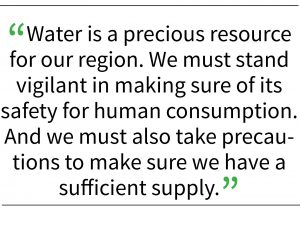Two million residents of Santa Clara County face a future with potential water restrictions.
Editorial is the opinion of Morgan Hill Life
In 2017 California had one of the wettest seasons in decades. The Sierra snowpack was 164 percent of historical average. And throughout the state reservoirs were completely filled, including San Luis Reservoir, which provides our region with much of its water.
But now in 2021, the two million residents of Santa Clara County face a future with potential water restrictions. Despite several winter storms that have brought rain to coastal California the past few months, the U.S. Drought Monitor is classifying most of Santa Clara County as being in a “moderate drought.” We might get lucky and spring rains in April and May might deluge the region and help fill our reservoirs, but let’s not count on it.
 According to information given at a March 16 press conference by Valley Water officials, we need to make sure we keep on conserving our water supply today to meet future needs. Caught between climate change and multi-year droughts, Californians have been tapping groundwater and siphoning surface water at unsustainable rates. The state faces historic lows in rainfall, with the current precipitation at only 30 percent to 70 percent of what the state would expect to have seen during a normal rain season.
According to information given at a March 16 press conference by Valley Water officials, we need to make sure we keep on conserving our water supply today to meet future needs. Caught between climate change and multi-year droughts, Californians have been tapping groundwater and siphoning surface water at unsustainable rates. The state faces historic lows in rainfall, with the current precipitation at only 30 percent to 70 percent of what the state would expect to have seen during a normal rain season.
In the county, rainfall in San Jose is below 50 percent of normal. Our local reservoirs are at 30 percent of normal — and Anderson Reservoir in Morgan Hill (the county’s largest reservoir) is at only three percent capacity because water was drained last year to prepare for a retrofit of Anderson Dam due to the danger of an earthquake collapsing the structure. While work is done on the dam during the next decade, Valley Water will need to rely on more imported water to fill the region’s need.
 Imported water is also at lower levels than four years ago. Sierra snowpack is just 61 percent of normal, reducing our ability to import melt-off water. Most of the state of California’s imported water supplies are below normal. Luckily, the county’s aquifers can provide water now, but we need to consider the environmental consequences if we draw too much during a drought.
Imported water is also at lower levels than four years ago. Sierra snowpack is just 61 percent of normal, reducing our ability to import melt-off water. Most of the state of California’s imported water supplies are below normal. Luckily, the county’s aquifers can provide water now, but we need to consider the environmental consequences if we draw too much during a drought.
“We currently have healthy ground water levels, but our projection shows that we will need supplemental imported water to maintain healthy ground water levels and prevent subsidence,” said Aaron Baker, chief operating officer of the Water Utility Enterprise, during the press conference.
It’s not just the supply of water but also its safety for public and business consumption, something that Valley Water takes seriously. There are lessons we can learn from other regions of the U.S. Starting in 2014, Flint, Mich., residents faced a public health crisis that lasted until 2019 following the city’s officials decision to save money during a budget crisis to change the city’s treated water from Lake Huron and the Detroit River to the nearby Flint River. It resulted in about 100,000 residents exposed to lead contaminated and possibly Legionella bacteria. In Texas during the January blizzard that brought down much of the energy distribution system, frozen water pipes broke in homes and people across the Lone Star State had to boil water for fear of contamination from bacteria.
Last month, the 15,000 residents of the west coast Florida city of Oldsmar faced a public health threat to their water’s safety when a hacker broke through the security system and was able to take remote control of the software function to control the water being treated. The intruder in this cyber-attack boosted the level of sodium hydroxide — or lye (a main ingredient in liquid drain cleaners) — in the city’s water supply to 100 times higher than normal. By chance, the breech was viewed live by a technician who took steps to prevent the toxic substance from entering the water supply. No harm was done.
Soon after, Valley Water issued a statement that read in part: “At Valley Water, the safety and security of our water supplies is of utmost importance. That’s why we have invested in advanced technology and several layers of complex protections, including 24/7 monitoring by our essential workers, to prevent such a cyber-attack on our drinking water systems. Additionally, we have detection systems at our water treatment plants that will alert us of unsafe conditions long before the water would reach our retailers and eventually the taps of residents or businesses in Santa Clara County.”
Water is a precious resource for our region. We must stand vigilant in making sure of its safety for human consumption. And we must also take precautions to make sure we have a sufficient supply. We face climate change and extreme weather challenges that threaten our supply of clean water. That’s why we must make water conservation a way of life for all residents in the South Valley region and throughout Santa Clara County.







